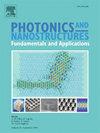Intelligent design of colored passive cooling multilayer films using bidirectional neural networks and genetic algorithms
IF 2.9
3区 物理与天体物理
Q3 MATERIALS SCIENCE, MULTIDISCIPLINARY
Photonics and Nanostructures-Fundamentals and Applications
Pub Date : 2025-09-01
DOI:10.1016/j.photonics.2025.101445
引用次数: 0
Abstract
Colored passive cooling combines vibrant coloration with passive cooling capabilities, attracting significant interest in sustainable energy applications. While nanostructured colored passive cooling designs show promise, achieving precise colors with cooling power remains computationally challenging due to complex geometric parameter optimization. This study presents an innovative bidirectional design framework combining bidirectional neural network (BNN) and genetic algorithm (GA), to assist in the design of multilayer films. BNN accurately forecasts color and cooling power (99.67 % accuracy) from structural parameters and temperature T, and inversely designs geometric parameters (99.86 % accuracy) based on desired color and cooling performance at the given temperature. Crucially, the GA-based framework explores multiple high-precision solutions based on desired parameters, effectively addressing the “one-to-many” inverse design problem, overcoming the BNN’s single-solution limitation. The designed PMMA/TiN/TiO2/Ag films achieve a broad color gamut, covering 62 % of the CIE-1931 color space, while maintaining its equilibrium temperature only 2 −3 K above the ideal device. Together, these machine learning frameworks establish a full-cycle design paradigm: BNN enables bidirectional property-structure mapping with ultra-high accuracy while the GA- forward prediction model hybrid efficiently generates diverse optimal designs satisfying multi-objective constraints. This dual methodology accelerates the discovery of novel colored passive coolers, accelerating the development and deployment of energy-efficient solutions for significant contributions to energy conservation and sustainable development.
基于双向神经网络和遗传算法的彩色被动冷却多层膜的智能设计
彩色被动冷却结合了充满活力的色彩和被动冷却能力,吸引了可持续能源应用的显著兴趣。虽然纳米结构彩色被动冷却设计显示出前景,但由于复杂的几何参数优化,通过冷却功率实现精确的颜色仍然具有计算挑战性。本研究提出了一种结合双向神经网络(BNN)和遗传算法(GA)的创新双向设计框架,以辅助多层薄膜的设计。BNN根据结构参数和温度T准确预测颜色和冷却功率(99.67 %准确率),并根据给定温度下所需的颜色和冷却性能反设计几何参数(99.86 %准确率)。至关重要的是,基于遗传算法的框架探索了基于所需参数的多个高精度解,有效地解决了“一对多”反设计问题,克服了BNN的单解限制。所设计的PMMA/TiN/TiO2/Ag薄膜具有较宽的色域,覆盖了CIE-1931颜色空间的62% %,同时其平衡温度仅比理想器件高2 −3 K。总之,这些机器学习框架建立了一个全周期的设计范式:BNN实现了高精度的双向属性-结构映射,而遗传算法-前向预测模型混合有效地生成满足多目标约束的各种优化设计。这种双重方法加速了新型彩色被动式冷却器的发现,加速了节能解决方案的开发和部署,为节能和可持续发展做出了重大贡献。
本文章由计算机程序翻译,如有差异,请以英文原文为准。
求助全文
约1分钟内获得全文
求助全文
来源期刊
CiteScore
5.00
自引率
3.70%
发文量
77
审稿时长
62 days
期刊介绍:
This journal establishes a dedicated channel for physicists, material scientists, chemists, engineers and computer scientists who are interested in photonics and nanostructures, and especially in research related to photonic crystals, photonic band gaps and metamaterials. The Journal sheds light on the latest developments in this growing field of science that will see the emergence of faster telecommunications and ultimately computers that use light instead of electrons to connect components.

 求助内容:
求助内容: 应助结果提醒方式:
应助结果提醒方式:


